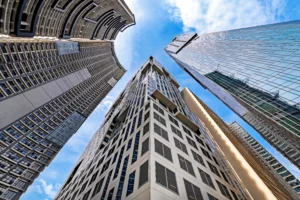A discourse about architecture, passion, stories, and the metro’s burgeoning skyline with Daniel Libeskind
Lewis Caroll wrote in Alice in Wonderland that “you have to do six impossible things before breakfast.” Since opening his architectural studio in Berlin in 1989, Daniel Libeskind has been doing not a few impossible things that may or may not have transpired over toast and coffee. His designs—whether it’s a modest house in Connecticut, a Jewish Museum in Berlin, a skyscraper in Singapore, or a master plan of New York’s Ground Zero—have distinctive forms that rebel against the slick and the smooth. A Libeskind building sings or tells a story, the kind of architecture that is visible wherever it is. And soon it will be seen in the skyline of Makati.
During his second visit to the Philippines for the groundbreaking of Century Properties’ Century Spire, a mixed-used, 60-story tower in Makati City, Daniel talked quite passionately about how Manila is now a true example of what is happening in the world today.
“The world, in terms of architecture above anything else, is competing, and the competition is not as much national but about cities, world cities. And what makes a great city is what I saw here when I shook hands with would-be architects. I saw bright eyes and ambition, the fact that Metro Manila is now opening up to building something with the spirit of the city, of its culture, is something that ultimately touches my heart because it’s so human,” Daniel muses.
“So when I had the opportunity to work with Century Properties, I fell in love with the Filipinos’ passion because to me, passion and creativity are what makes cities. The competition of cities is of course done with infrastructures, buildings, public transport, but what do they depend on ultimately? They depend on human desire, on the passion and intensity to work on something which initially may seem impossible. And Manila is brimming with that desire now.”
THE CRUX OF THE STORY
Unlike philosopher Ludwig Wittgenstein, who believed that where there is silence there is nothing more to say, Daniel believes that where there is silence, there is most to be said. He never believed in the silent space of architecture where the forms create the illusion that all has been said, to let people take in its design at face value. “I always find a narrative in my designs through research. If there wasn’t a story to tell, then what’s the point?” he contemplates. “If something is created with a heart and in a way which is memorable, it can be passed on from generation to generation. And that to me is the definition of architecture, because while architecture has a lot to do with a place or where it is located. It has to tell a story, often that story is not the story we already know about the place. It’s something that was not so visible before but has always been there.”
Thus, according to Daniel, Century Spires tells the story of creativity, the story of Makati CBD, the story of the site, of the light of the Philippines. And all those factors fundamentally developed the shape, the character, and the sculptural quality of the building. “It is, of course, a contemporary building, very modern. But it is shaped and crafted in a very particular way to be a building that works and fits into the different landscapes of the lives of Filipinos.”
OPENING UP TO NEW HORIZONS
Century Spires is a glass-and-steel, high-rise tower that expands with a dramatic crown as it rises. As the building’s tower shaft extrudes upward from the street, it divides subtly into three branches that rise to different heights.
Daniel created a design crescendo at the top of the tower by placing a glass-clad form between the two highest tower shafts. Introducing this fourth volume at the crown also serves to provide more floor space for the spacious, light-filled penthouses with spectacular views of the surrounding city and Manila Bay. The slim tower profile at the base of the building provides a benefit as well by maximizing public space to the east of the tower, for a new, landscaped public plaza.
“The goal was to create a building that is practical, economical, but at the end speaks with the light of Metro Manila that opens itself up to new horizons, which everyone here will experience more and more in just a few years, I am very sure. And I love the idea of a city aspiring, a city being elevated,” Daniel enthuses. “I had a wonderful time working with Century Properties Group and Armani/Casa Interior Design Studio in a project that I think will contribute something not only to the people who will be living and working in the building, but really to the awareness of what culture through architecture and design can do for a city.”
Daniel began his career as a musician and then became an architect, which explains his artistic, poetic, and lyrical ideas that, for him, are very hard to convey in his chosen profession because “architecture is very slow to change in comparison with a thought, a brush stroke, or a note.” That’s why his only tip for Filipino architects and students: Be creative.
“I suggest to students of architecture to take the necessary risks not to just go to what has been done before, go forward. Invent things that have never been done, be daring because only if one is daring and bold can one do something that is not so easy to achieve. Don’t just look into the magazines, and look at what has been done. Go off, Take a risk. Don’t worry if people criticize you. Don’t worry if people think you are crazy, because that’s when you know you’ll ultimately succeed,” he says.
Source: Manila Bulletin | July 13, 2014





